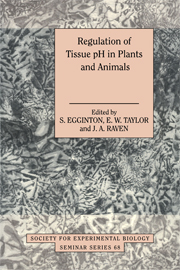Book contents
- Frontmatter
- Contents
- List of contributors
- Preface
- Measurement of intracellular pH: a comparison between ion-sensitive microelectrodes and fluorescent dyes
- pH-sensitive microelectrodes: how to use them in plant cells
- The use of nuclear magnetic resonance for examining pH in living systems
- Invasive studies of intracellular acid–base parameters: quantitative analyses during environmental and functional stress
- Lactate, H+ and ammonia transport and distribution in rainbow trout white muscle after exhaustive exercise
- Limiting factors for acid–base regulation in fish: branchial transfer capacity versus diffusive loss of acid–base relevant ions
- H+-mediated control of ion channels in guard cells of higher plants
- pH regulation of plants with CO2-concentrating mechanisms
- Intracellular pH regulation in plants under anoxia
- The role of turtle shell in acid–base buffering
- Acid–base regulation in crustaceans: the role of bicarbonate ions
- A novel role for the gut of seawater teleosts in acid–base balance
- pH and smooth muscle: regulation and functional effects
- Regulation of pH in vertebrate red blood cells
- Acid–base regulation in hibernation and aestivation
- Hepatic metabolism and pH in starvation and refeeding
- Back to basics: a plea for a fundamental reappraisal of the representation of acidity and basicity in biological solutions
- Index
Back to basics: a plea for a fundamental reappraisal of the representation of acidity and basicity in biological solutions
Published online by Cambridge University Press: 22 August 2009
- Frontmatter
- Contents
- List of contributors
- Preface
- Measurement of intracellular pH: a comparison between ion-sensitive microelectrodes and fluorescent dyes
- pH-sensitive microelectrodes: how to use them in plant cells
- The use of nuclear magnetic resonance for examining pH in living systems
- Invasive studies of intracellular acid–base parameters: quantitative analyses during environmental and functional stress
- Lactate, H+ and ammonia transport and distribution in rainbow trout white muscle after exhaustive exercise
- Limiting factors for acid–base regulation in fish: branchial transfer capacity versus diffusive loss of acid–base relevant ions
- H+-mediated control of ion channels in guard cells of higher plants
- pH regulation of plants with CO2-concentrating mechanisms
- Intracellular pH regulation in plants under anoxia
- The role of turtle shell in acid–base buffering
- Acid–base regulation in crustaceans: the role of bicarbonate ions
- A novel role for the gut of seawater teleosts in acid–base balance
- pH and smooth muscle: regulation and functional effects
- Regulation of pH in vertebrate red blood cells
- Acid–base regulation in hibernation and aestivation
- Hepatic metabolism and pH in starvation and refeeding
- Back to basics: a plea for a fundamental reappraisal of the representation of acidity and basicity in biological solutions
- Index
Summary
Introduction
The acid–base status of an aqueous solution is reflected by the relative activities of hydrogen ({H+}) and hydroxide ({OH−}) ions. These two quantities can be altered by changes in temperature, the concentrations of weak and strong electrolytes, and PCO2 (Stewart, 1978). In biological solutions, {H+} is determined by the strong ion difference (SID) (defined as the sum of all strong base cations minus the sum of all strong acid anions), PCO2, and the total weak acids present. At constant temperature, acid–base status can be changed only by changes in one or more of these independent variables (Stewart, 1978).
The maintenance of a stable acid–base status of the internal body fluids is thought to be of importance to animals primarily because of the need to maintain protein function. Protein structure (and hence function) is dependent on the degree of ionisation of the component amino acids and of the α-imidazole group in particular (Reeves, 1972). The degree of ionisation of amino acids can be altered by changes in the acid–base conditions of the medium. To preserve protein function and maintain the physiological processes to which it contributes, animals must regulate acid–base status and may, for example when faced by changes in temperature, either maintain a constant relative alkalinity (see below), or regulate pH independently of temperature, in order to depress or enhance rates of metabolism (see Whiteley, this volume).
To understand fully how these processes are affected by acid–base conditions and how acid–base status is maintained in living organisms requires a suitable means for representing the acid–base status of a solution.
- Type
- Chapter
- Information
- Regulation of Tissue pH in Plants and AnimalsA Reappraisal of Current Techniques, pp. 353 - 372Publisher: Cambridge University PressPrint publication year: 1999
- 1
- Cited by



